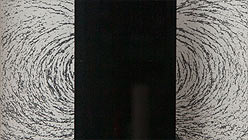In 1809, the German mathematician Carl Friedrich Gauss published Theoria motus corporum coelestium in sectionibus conicis solem ambientum (Theory of Motion of the Celestial Bodies Moving in Conic Sections Around the Sun), which introduced the idea of the Gaussian gravitational constant. Gauss is responsible for our modern understanding of magnetism and for the term “degaussing” (the process of decreasing an unwanted magnetic field was named after him).
Hunter Longe’s new body of work, Degausser, is a meditation on the literal and conceptual manifestations of magnetism and polarity. Longe incorporates video, drawing, printed matter, photography, and found objects into an installation that quotes his twentieth-century art-historical forefathers through the suggestion of skewed perception. Longe has taken the degausser — a device used to correct magnetic imbalance in a device like a television — and reversed its utility. He discovered that the device could be used to distort an otherwise normal video or set a clock running backward. The term “degaussing” can be applied to the multitude of ways Longe has found to obscure, distort, and conceal found images and objects.
Notably, Longe’s exhibition is the inaugural venture for The Popular Workshop in its new capacity as a gallery featuring the work of emerging artists. The Popular Workshop is also a creative agency and design studio, now merging its interests in the overlap between art and design. Longe fills the gallery’s cavernous and somewhat idiosyncratic space in interesting ways; a twenty-by-forty-foot graphite wall drawing, Magnetic Field Study Enlarged 20 times (2011), provides an apt backdrop (visually and conceptually) for the smaller works on view. Framed works on paper and video pieces are clustered in groups, with backward-running clocks scattered intermittently, creating a kind of Twilight Zone atmosphere. The exhibition is a whimsical display of framed pieces and small, antiquated television sets placed on staggered, wall-mounted shelves. The presentation has the feel of a minimal and outdated department store, thrown uncontrollably out of whack.

Gerhard’s Müller Behind Plastic, 2011; Courtesy of the Artist and the Popular Workshop, San Francisco.
Many of Longe’s pieces riff on the visual ideas of late twentieth-century artists such as Bruce Conner, Jay DeFeo, and Wallace Berman, paying particular attention to Bay Area darlings of the Beat generation. Most notable among these pieces is Gerhard’s Müller Behind Plastic (2011), an exquisite to-scale pencil drawing on paper of Gerhard Richter’s oil painting Portrait Müller (1965), wrapped in plastic. With a piece like this, Longe demonstrates amazing technical expertise while ruminating on the seemingly impossible task of any young artist: to make something new. Longe’s solution is to cleverly admit that this pursuit is inevitably futile. Instead, Longe quotes his idols in ways that remind us of the complex system in which older pieces of art and contemporary artists coexist in the world. It’s clear, in looking at Gerhard’s Müller Behind Plastic and understanding how it was made, that Longe has been privy to the inner sanctum of storage for works like the Richter painting. Art icons of the late twentieth century are crucial parts of Longe’s visual lexicon; when he sees a hand holding a degausser, he sees Wallace Berman’s talismanic reproductions of transistor radios. He quotes these icons in a manner that simply emphasizes their ubiquity — a pithy reminder that these images are always hanging in the air.


